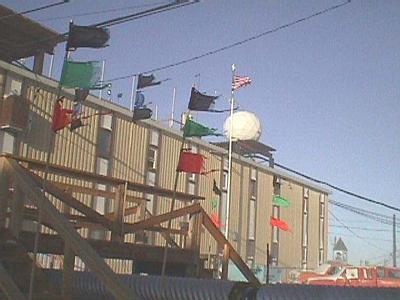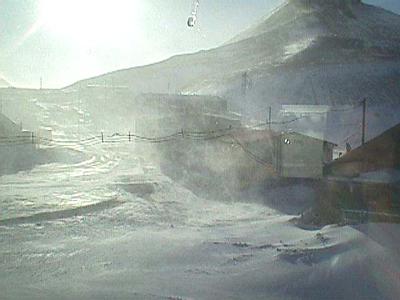8 November, 1999
Well, you're reading this journal entry so you know what that means. "Strike
two" on my attempt at the flight to Cape Roberts. I got all dressed in my
ECW gear and started to the helo pad. The weather was clearing so I was
hopeful. But alas, the flight was cancelled due to weather along the route.
I might have another chance on Wednesday. The good news is that when I woke
up this morning there were clear blue skies. But, wow, was it windy. It
seemed windier then yesterday when we had peak winds of 70 MPH! As I looked
out over the frozen Ross Sea towards the ice runway, the surface was
completely obliterated with snow. It was weird to see clear skies and a
whiteout at the surface. Later in the day, the winds slowed down a bit, but
it is still a bit breezy. Planes and helos are flying. A flight from
Christchurch is on its way and LC-130's are headed to field camps and the
Pole.
The forecast today called for a high temperature of 30F, almost to
the freezing point of water. That's pretty warm for here. But, of course
temperature only tells part of the story. The constant wind makes it fell
much colder to a person out in the weather. This is due to what we call The
Wind Chill Factor. The wind chill factor or wind chill index is a number
which expresses the cooling effect of moving air on human skin at different
temperatures. It indicates, in a very general way, how many calories of heat
are carried away from the surface of the body. The Antarctic explorer, Paul
A. Siple, developed the Wind Chill index in 1939. Siple was the youngest
member of Admiral Byrd's Antarctica expedition in 1928-1930 and later made
other trips to the Antarctic. Siple Dome, site of a scientific field camp on
the ice cap, was named after him.
Wind chill factors are supposed to measure the effect of the combination of
wind speed and temperature upon human comfort. Wind chills can be
determined by using a chart or they can be calculated using one of several
formulas. Here is one that can be used:
Wind chill = 91.4 - (0.474677 - 0.020425 * W + 0.303107 * SQRT(W)) * (91.4 -
T)
where W = wind speed (mph) & T = temperature (°F)
However, these determinations are only estimates of the effect on a person.
Each person will be effected differently. Also, there is nothing exact about
wind-chill. It is an estimation of apparent temperature. It is important to
remember that wind does not have the same effect on inanimate objects. For
example, if it's 20F outside with a 20 MPH wind, the wind-chill may make it
feel to a person like -9F, but your car will still be at a temperature of
20F. People who are sheltered from the wind are also not affected by
wind-chill.
It is important that when you are out in the cold that you protect
yourself from the wind. Warm clothing alone is not enough to protect you
from heat loss on a cold, windy day. The ECW gear we were issued includes
wind pants, a wind proof hat and the parka serves as an effective
windbreaker. However, these don't help you from having to walk head long
into a 70-MPH wind on your way to lunch! It's a lot of work!
Today's featured CRP Team Members are three of the sedimentologists on the
project. They are Malcolm Laird of Canterbury University in Christchurch,
New Zealand, Tim Nash from the Institute of Geological & Nuclear Sciences in
Lower Hutt, New Zealand and Ross Powell of Northern Illinois University in
Dekalb, Illinois. Sedimentologists are some of the first scientist to
examine the core when it comes out of the ground. There are sedimentologists
at the drill site at Cape Roberts who initially examine and describe the
core. The core along with their descriptions are then sent to Crary Lab
where another group of sedimentologists examine and describe the core before
the scientists form the other disciplines decide which parts they wish to
sample. The sedimentologists describe the physical appearance and texture of
the rock (sandstone, mudstone, conglomerate, etc) and make a first
determination as to the environment in which the sediments were deposited.

The flags were straight out in the wind today at the weather office.

Blowing snow in the streets of Mactown.

Clearing the road to the ice runway. Note how far the snow is being blown by the wind.

A Wind-chill Chart

From left to right: Malcolm Laird, Tim Nash and Ross Powell examining a new set of core samples.
Contact the TEA in the field at
.
If you cannot connect through your browser, copy the
TEA's e-mail address in the "To:" line of
your favorite e-mail package.
|
